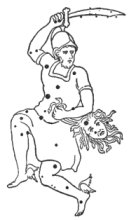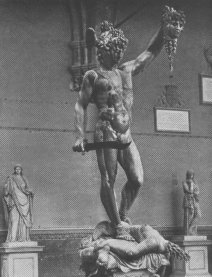Mythology of Perseus
All of the following material was taken directly from William Tyler Olcott's book entitled Star Lore of All Ages, published in 1911 by The Knickerbocker Press. William Tyler Olcott was the founder of the AAVSO in 1911.
Perseus the Champion
 |
Perseus seek for by her feet Which ever at his shoulder are revolving. Tallest of all his compeers at the North He towers. His right hand stretches toward the chair Of his bride's mother. |
| Frothingham's Aratos |
In the legend of the sacrifice of Andromeda, Perseus figures as the hero, and hence we find his constellation situated close to the groups that represent the unfortunate maiden and the ferocious monster that sought to destroy her.
We can never be sure whether the constellation suggested the legend, or the legend the constellation. It may be, as one authority points out, that the legend was suggested by the fact that the constellation Perseus, rising before Andromeda, seems to deliver it from the night, which might well be depicted as a monster, such as appears in the figure of the constellation Cetus.
It seems, however, as if there were a deeper significance in this story that the stars illustrate, of a conflict between man and beast, with a human sacrifice at stake, and the eventual triumph of man.
We find among the stellar figures many conflicts of this nature depicted, and in no case do we find man overcome in the struggle that he is engaged in.
Hercules and Ophiuchus are seen respectively trampling underfoot or holding securely gigantic reptiles. The Archer is about to slay the Scorpion, and Orion threatens undismayed the advancing Bull. Perseus, flying from his victory over the dread Medusa, slays the monster of the deep, and rescues the fair Andromeda.
This universal victory of humanity over the animal world, depicted in the constellations, is one of the chief features of these time-honoured configurations, and is clearly indicative of the fact that the ancient star groups are the product of design and not chance.
|
Perseus, because of his gallantry, is known as "the Knight Errant of Mythology." The hero was the son of Jupiter and Danaë, and the favourite of the gods. His successful encounter with the Medusa rendered his name immortal, and at his death, it is said, he was transported to the starry skies, where he appears with upraised sword, holding the severed head of the Medusa up to the gaze of all mankind, for all time.
Plunket is of the opinion that the constellation was invented about 1433 BC, as at that time the star Algol, the well-known variable and most interesting star in the constellation, exactly marked the equinoctial meridian.
Aratos, in an allusion to Perseus, describes him as "stirring up the dust in heaven," so great was his haste to rescue Andromeda. It has been suggested that the dust may be represented by the Milky Way, in a part of which the constellation is located.
Without doubt the story of Perseus was well known in Greece anterior to the 5th century B.C., for Euripides and Sophocles each wrote a drama based on Andromeda's history.
Arabs called the constellation "Bearer of the Demon's Head," which is represented by the star Beta Persei, known generally as "Algol." Perseus has also been called "the Rescuer," and "the Destroyer." Dr. Seiss regards the figure as symbolising the Redeemer of Mankind, and others have claimed that Perseus represents David with the head of Goliath, and the Apostle Paul with his sword and book.
The constellation is 28 degrees in length, one of the most extended in the heavens. Its principal stars form a curved line that bears the name of "the Segment of Perseus," a figure that is almost as much of a stellar landmark as the Great Square of Pegasus.


